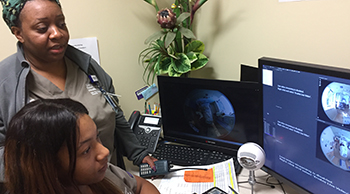-
Services
Featured Specialties
-
Locations
Location Type
-
Patients & Visitors

Constant companions Destahni Swindell (seated) and Nicole Gamble watch patients via a video monitoring system on the General Medicine unit (EP 9-7). The video monitoring project is designed to help prevent falls and other activities that could harm patients.
From a video monitoring station, constant companion Destahni Swindell has been watching her five patients for several hours, so she’s become familiar with their body language.
She can tell when one of her patients, who periodically stands up from his chair to stretch, is about to take it one step further – literally – and try to walk unassisted. That prompts a call to fellow constant companion Nicole Gamble, who can rush to the patient’s room to help him before he falls.
Swindell and Gamble are participating in a video monitoring project on General Medicine units EP 9-5 and 9-7 that’s designed to enhance safety for patients at high risk for falls, elopement, confusion or self-harm.
Five rooms on each unit are equipped with non-recording cameras and speakers so a constant companion in the monitoring station can watch and communicate with high-risk patients, around the clock. A second constant companion serves as rounder, checking on patients to see if they need help getting to the bathroom or other assistance. The rounder and/or other nearby unit staff members respond to alerts from the monitoring station, signaled by blue lights outside the rooms.
“The monitoring staff frequently catch people trying to get up, and the rounders rush to those rooms to help,” said Dawn Dowd, RN, assistant patient service manager of the Nursing Resource Operation Center and video monitoring project lead. “Every day, they prevent safety incidents, some of which could cause serious harm to patients.”
Communication between the monitoring staff and unit clinical staff also enhances patient safety. Nurses provide monitors information about patients’ conditions or treatments that could increase the potential for falls or other risks, and monitoring staff update clinical staff on patients’ activities in their rooms.
The video monitoring project is based on similar, successful programs at Bridgeport and Greenwich hospitals. Improving safety and reducing falls are the main objectives, but video monitoring can also help lower costs, by reducing the number of constant companions needed to sit with individual patients. The project has been well-received, said Janet Marseglia, RN, director of Nursing, Resource Operation Center and Business Office.
“Patients don’t always like to have a person in the room with them, but they like to be checked on,” she said. “The families of our elderly and confused patients in particular like the video monitoring, because it provides extra security.”
The Department of Medicine and the Nursing Resource Operation Center worked with a number of other departments to implement the project, including Yale New Haven Health System’s Internal Consulting Group, Information Technology Services and Finance departments, and the hospital’s Protective Services and Facilities and Engineering.